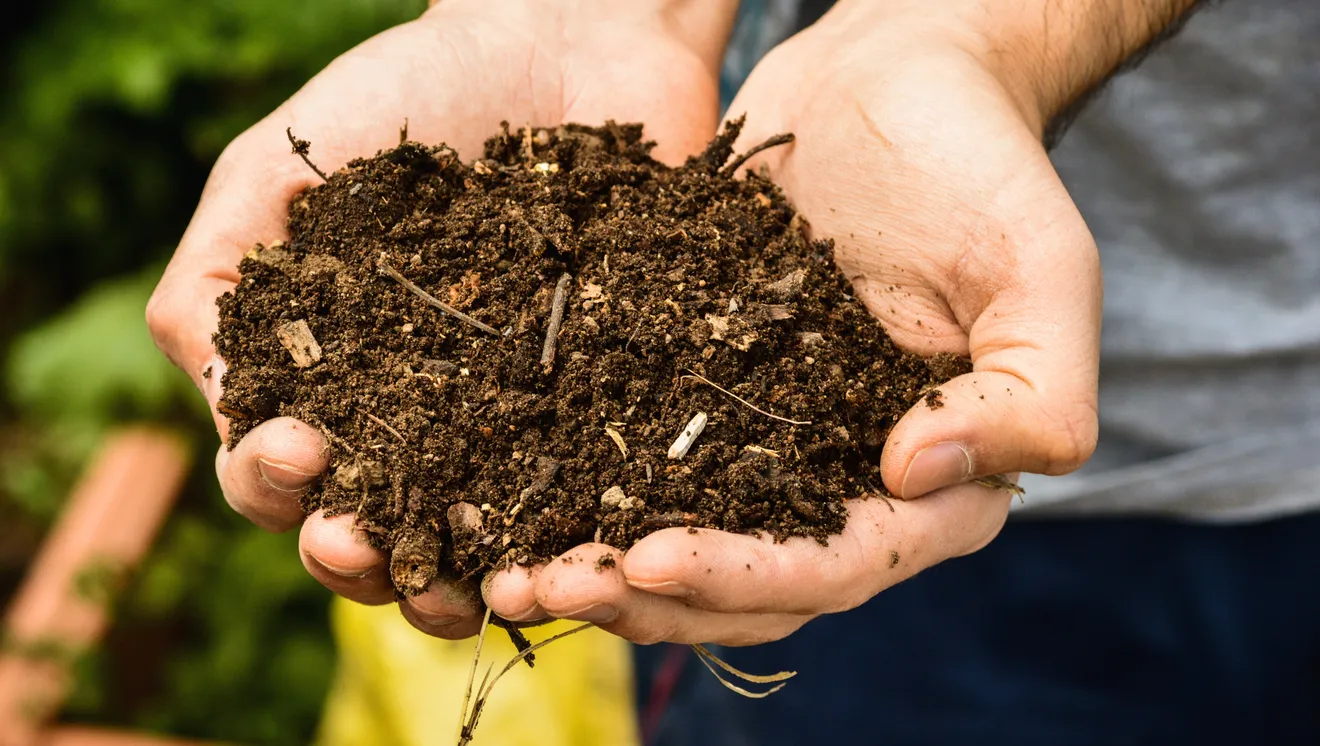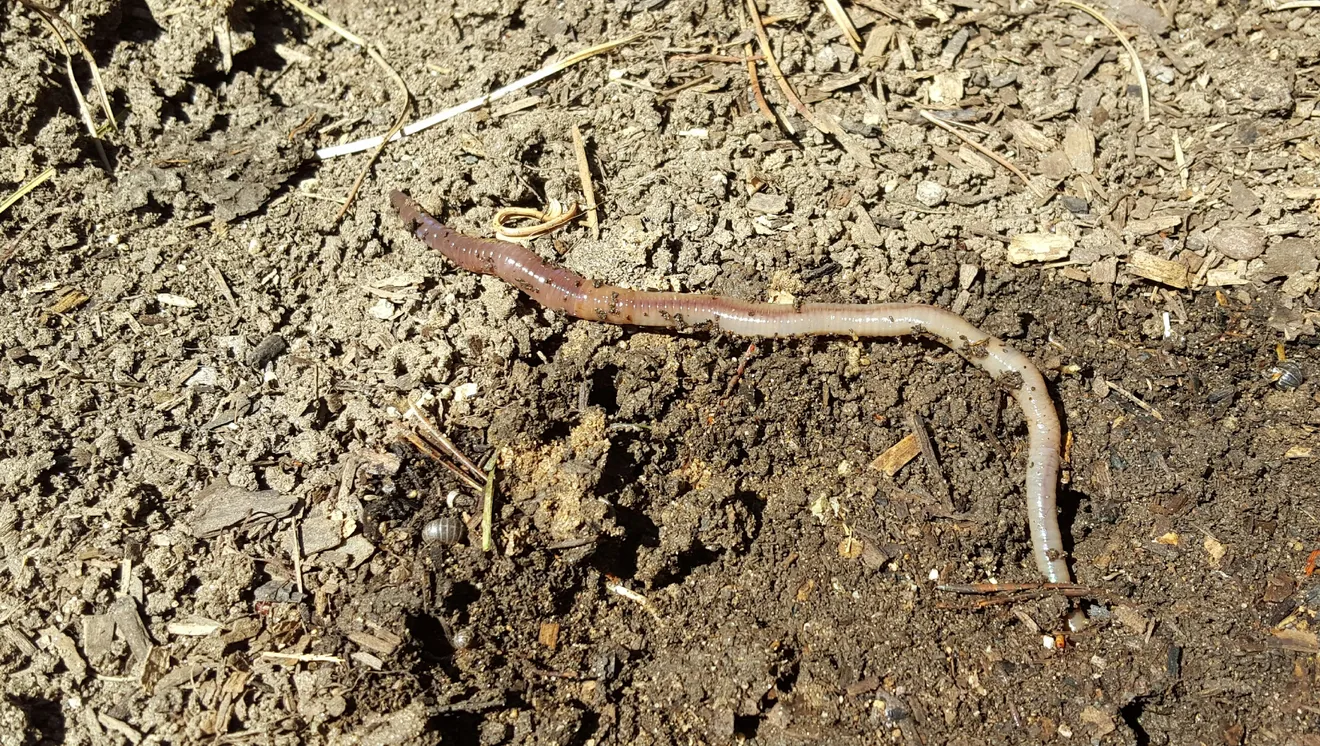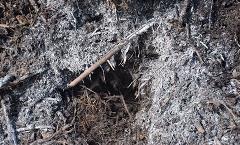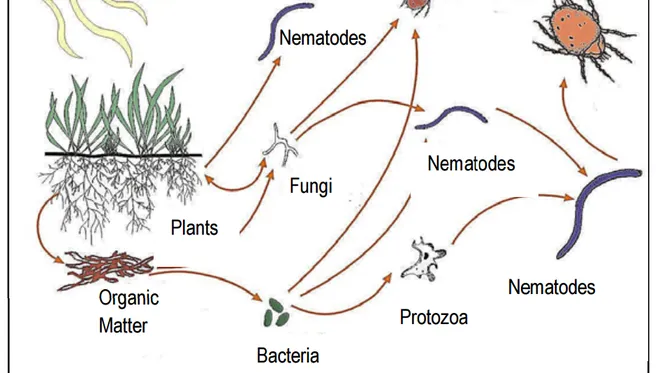Master Gardener: The ecosystem of compost piles – Compost Pile Microbes
If you have been keeping a compost pile, you have been maintaining an active ecosystem that is based on the breakdown of the organic materials that you are composting. With optimal conditions, your compost pile should have all the components of an active ecosystem. All healthy ecosystems consist of an energy source, primary consumers and multiple levels of secondary or tertiary consumers that form a healthy food web.
The base of the compost ecosystem is your compost, and the primary consumers are the organisms that feed on the compost, decomposing it into soil. Primary consumers include bacteria, fungi, actinomycetes and nematodes. These are the microscopic decomposers. Decomposers that you might see are mites, earthworms, beetle larvae, millipedes, sowbugs, snails, slugs and whiteworms. It is important to maintain the right habitat for the decomposers to work your compost pile. Here, you need to ensure that the pile is kept sufficiently moist, but without standing water. Creating a higher temperature in your compost pile, 120 to 160 degrees F, will speed up the life cycles of the decomposers and the breakdown of your compost into soil.

The size and abundance of secondary consumers can be used to estimate the health of your compost pile. A healthy compost pile will have more secondary consumers because there is more prey from primary consumers for the secondary consumers to consume. Secondary and tertiary consumers include carabid beetles, rove beetles, earwigs, other beetles, ants, mites, spiders, pseudoscorpions, centipedes, springtails, soil flatworms, nematodes, protozoa and rotifera.
While a healthy compost pile ecosystem will help break down the compost into beautiful soil, compost can create a source habitat for garden pests or annoying insects that can ruin your barbecue. Place your compost pile away from garden, patio or picnic areas to prevent issues with flies, ants, sowbugs and snails. Fruit flies and houseflies can increase with too much fresh fruit or vegetable waste, so add these to the compost pile slowly over time or after a hard freeze. Placing the pile away from the garden will reduce the sowbugs and snails that can move from your compost to your vegetables. Scarab beetle larvae can invade lawns and vegetables, so look for large C-shaped beetle larvae in your pile.

For an opportunity to learn more about decomposer and pest insects, pollinator and beneficial insects, composting and more, check out our “Grow Your Own, Nevada!” program. The program is a series of eight gardening workshops held 6 to 8 p.m., Tuesdays and Thursdays, May 3 through May 26.
Workshop topics include:
- 5/3- Warm-season vegetable gardening
- 5/5- Gardening in Nevada’s soils
- 5/10- Know Nevada insects: Decomposers & pests
- 5/12- Know Nevada Insects: Pollinators & beneficials
- 5/17- Tomatoes 101
- 5/19- Composting made easy
- 5/24- Preservng the harvest: Hot-water canning
- 5/26- Seed saving
Compost Pile Microbes
The process of decomposition is complex but natural. Many organisms work to break down organic matter. Most are not seen by the human eye. Others that are large enough to see are usually associated with the later breakdown stages. A succession of microbes and insects combine efforts to turn feedstocks, such as leaves, grass clippings, yard prunings and food waste, into the fully decomposed finished product known as compost.
The Compost Food Web
If you are composting for the first time, you may be surprised by the size and complexity of the community of small organisms that take up residence in your compost pile. These organisms, which include many insects, bugs, slugs, bacteria, and fungi, form what is called a “food web.” In the food web, each organism has a job to do in turning your organic waste into dark, crumbly finished compost.
The food web decomposition process is divided into three levels:
- Level One (primary consumers) is comprised of the organisms that shred organic matter and the microscopic organisms that eat the shredded organic residues.
- Level Two (secondary consumers) is comprised of the organisms that eat level one organisms.
- Level Three (tertiary consumers) is comprised of the organisms that eat level two organisms.
Organic Material Decomposition
The macro-organisms you can see in or around your compost pile, such as mites, centipedes, sow bugs, snails, beetles, ants and earthworms, are physical decomposers; they grind, tear, and chew materials into smaller pieces. However, micro-organisms such as bacteria, fungi, and actinomycetes–even though they go unnoticed in your compost pile–are responsible for most of the organic material breakdown. They are chemical decomposers because they use chemicals in their bodies to break down organic matter. The most abundant type of chemical decomposer in a compost pile is aerobic bacteria. When they break down organic material, they give off heat. Billions of aerobic bacteria working to decompose the organic matter in a compost pile causes the pile to warm up.
As the temperature rises, different organisms thrive. Psychrophilic bacteria are most active at around 55oF. Mesophilic bacteria take over around 70oF up to 100oF. When the compost pile temperature goes over 100oF, the heat loving thermophilic bacteria take over. Thermophilic bacteria prefer a temperature between 113oF and 160oF. If the pile heats to more than 160oF, bacteria begin to die off and decomposition slows down. This is why experts recommend turning your pile before the temperature exceeds 160oF.
As thermophilic bacteria run out of food, the pile will cool and the makeup of the microbial community will shift back towards cooler-temperature bacteria. This is when fungi become more active in the compost pile. Fungi prefer a temperature range between 70oF and 75oF and do a great job breaking down cellulose and lignin, the woody materials in your pile. The difficult process of breaking down these more complex materials can take many weeks.

Actinomycetes are fungi-like bacteria that are light greyish in color and credited with creating the Earthy aroma of good compost. Along with fungi, Actinomycetes play a critical role in degrading the more complex woody materials in your compost pile, such as lignin, chitin, cellulose and proteins. These bacteria prefer a high pH and generally work in moderate temperatures. In mature compost, Actinomycetes can be seen as long threadlike filaments stretching through the compost. Some say Actinomycetes in compost resembles cobwebs.
(Photo by Matt Cotton, Integrated Waste Management Consulting.)
Avoiding odors
Research by Cecilia Sundberg, from the Swedish University of Ag Sciences, shows that a low pH is correlated with stronger odors and an increase in the emissions of volatile organic compounds (VOCs). This can be a concern when adding food to your pile, as some foods are acidic and can drop the pH. Large amounts of wet grass clippings can also cause strong odors if they become clumped or matted.
Odors may upset your neighbors, and VOC are bad for air quality; they react with engine emissions and sunlight to make ground-level ozone. The study recommended incorporating recycled finished compost into the compost pile and maintaining high aeration rates during the initial compost process. Both of these suggestions are intended to keep oxygen throughout the pile. This will help to keep the pile from becoming too hot, becoming anaerobic and to prevent the compost from developing an acidic or low pH. The recycled compost works as a bulking agent creating space for air to enter the pile and gives a boost of microbes to get the decomposition process moving. For a large compost pile, high aeration rates can be achieved by increasing the airflow though the compost with pressurized air pushed or pulled through the pile.
For a small compost pile, high aeration rates can be achieved by turning the pile more often, and especially whenever the temperature approaches 160oF. Placing perforated aeration pipes through the pile can also help. These are typically placed horizontally in the lower part of the pile, and rely on heat convection or wind to move the air. Some passive designs may use perforated pipes placed vertically. Whether it’s food or piles of wet grass causing the odors, the remedy is often the same: more oxygen.
Maintaining the Balance
All members of the compost food web are very beneficial to a compost pile and should be left alone to do their work. They need each other to survive. Removing any of the member organisms through the use of insecticides will interfere with their natural cycle as well as contaminate your compost with insecticide residues. While the organisms are busy recovering from the imbalance created in their food web, your compost pile will decompose slower. For best results, don’t worry about the insects, they know what to do. Instead, focus on turning your compost regularly. Regular turning will distribute moisture evenly, prevent your compost from compacting, and will allow oxygen to infiltrate the entire pile. All of these conditions help speed up the natural process, lead to complete decomposition, and enhance the production of the finished product we call compost.
The “Great Escape” Issue
Home composters sometimes fear that the hungry organisms in the compost pile may escape to the garden or lawn and eat everything in sight. Fortunately, this is not the case. The compost pile is their preferred environment. In fact, other organisms from the garden or lawn may leave their homes and go into the compost pile!
However, if you are concerned about the food web in your compost pile “breaking out,” try the following tips:
- Create a barrier by spreading a line of wood ash (not barbecue ash because of fat residues) or crushed egg shells around your compost pile. This will keep the activity contained within the pile.
- A similar, but more lethal technique, is to sink small margarine containers full of stale beer, molasses and water, or yeast and water in the ground around the compost pile. Unsuspecting slugs, sow bugs, and earwigs will be attracted to the liquid, crawl inside, and drown.
Of course, some bugs and insects may overpopulate parts of your garden and have nothing to do with your compost pile. Use integrated pest management and non-lethal means whenever possible to keep them under control
Flies
Compost piles made entirely from yard trimmings do not usually attract large numbers of flies. So, large numbers of flies–particularly fruit flies—may mean you’re food waste is too close to the surface in your pile. Flies are attracted by meat or dairy products, and even animal manure. Reduce flies by keeping meat and dairy out of the pile. Bury all the plant food waste deep in the pile and cover the food waste with several inches of soil, finished compost or at least a foot of dry leaves. Ensure that the pile is not too damp or too acidic by maintaining a balance of materials. You can also compost your food waste in a worm bin. source
Vermicomposting
Vermicomposting is the practice of using worms to break down organic material, including food scraps. The resulting material is a mix of worm castings (worm manure) and decomposed food scraps.
The word “vermi” is Latin for worm. Worms like to feed on slowly decomposing organic materials like fruit and vegetable scraps. Worms produce castings that contain beneficial microbes and nutrients, which makes a great soil amendment. Worms are very efficient at breaking down food scraps and can eat over half their body weight in organic matter every day.
There are vermicomposting businesses in California making compost from the food waste they receive from restaurants and other industries. You can also vermicompost at home, school, and even the office on a smaller scale.
CalRecycle Resources
- Classroom worm composting
- Frequently asked question about worm composting
- Worms, a brochure on vermicomposting.
Other Resources
- Sonoma Farmer Turns to Worm Composting Video, San Francisco Chronicle
- The Power of Worms Episode 112 Video, Growing a Greener World
- Vermicomposting Resources. North Carolina State University Cooperative Extension
- Wikipedia page on Vermicomposting
- Worm Composting Headquarters
- source
Compost Microorganisms
by Nancy Trautmann and Elaina Olynciw
The Phases of Composting
In the process of composting, microorganisms break down organic matter and produce carbon dioxide, water, heat, and humus, the relatively stable organic end product. Under optimal conditions, composting proceeds through three phases: 1) the mesophilic, or moderate-temperature phase, which lasts for a couple of days, 2) the thermophilic, or high-temperature phase, which can last from a few days to several months, and finally, 3) a several-month cooling and maturation phase.

Different communities of microorganisms predominate during the various composting phases. Initial decomposition is carried out by mesophilic microorganisms, which rapidly break down the soluble, readily degradable compounds. The heat they produce causes the compost temperature to rapidly rise.
As the temperature rises above about 40°C, the mesophilic microorganisms become less competitive and are replaced by others that are thermophilic, or heat-loving. At temperatures of 55°C and above, many microorganisms that are human or plant pathogens are destroyed. Because temperatures over about 65°C kill many forms of microbes and limit the rate of decomposition, compost managers use aeration and mixing to keep the temperature below this point.
During the thermophilic phase, high temperatures accelerate the breakdown of proteins, fats, and complex carboydrates like cellulose and hemicellulose, the major structural molecules in plants. As the supply of these high-energy compounds becomes exhausted, the compost temperature gradually decreases and mesophilic microorganisms once again take over for the final phase of “curing” or maturation of the remaining organic matter.
Bacteria
Bacteria are the smallest living organisms and the most numerous in compost; they make up 80 to 90% of the billions of microorganisms typically found in a gram of compost. Bacteria are responsible for most of the decomposition and heat generation in compost. They are the most nutritionally diverse group of compost organisms, using a broad range of enzymes to chemically break down a variety of organic materials.
 Bacteria are single-celled and structured as either rod-shaped bacilli, sphere-shaped cocci or spiral-shaped spirilla. Many are motile, meaning that they have the ability to move under their own power. At the beginning of the composting process (0-40°C), mesophilic bacteria predominate. Most of these are forms that can also be found in topsoil.
Bacteria are single-celled and structured as either rod-shaped bacilli, sphere-shaped cocci or spiral-shaped spirilla. Many are motile, meaning that they have the ability to move under their own power. At the beginning of the composting process (0-40°C), mesophilic bacteria predominate. Most of these are forms that can also be found in topsoil.
 As the compost heats up above 40°C, thermophilic bacteria take over. The microbial populations during this phase are dominated by members of the genus Bacillus. The diversity of bacilli species is fairly high at temperatures from 50-55°C but decreases dramatically at 60°C or above. When conditions become unfavorable, bacilli survive by forming endospores, thick-walled spores that are highly resistant to heat, cold, dryness, or lack of food. They are ubiquitous in nature and become active whenever environmental conditions are favorable.
As the compost heats up above 40°C, thermophilic bacteria take over. The microbial populations during this phase are dominated by members of the genus Bacillus. The diversity of bacilli species is fairly high at temperatures from 50-55°C but decreases dramatically at 60°C or above. When conditions become unfavorable, bacilli survive by forming endospores, thick-walled spores that are highly resistant to heat, cold, dryness, or lack of food. They are ubiquitous in nature and become active whenever environmental conditions are favorable.
At the highest compost temperatures, bacteria of the genus Thermus have been isolated. Composters sometimes wonder how microorganisms evolved in nature that can withstand the high temperatures found in active compost. Thermus bacteria were first found in hot springs in Yellowstone National Park and may have evolved there. Other places where thermophilic conditions exist in nature include deep sea thermal vents, manure droppings, and accumulations of decomposing vegetation that have the right conditions to heat up just as they would in a compost pile.
Once the compost cools down, mesophilic bacteria again predominate. The numbers and types of mesophilic microbes that recolonize compost as it matures depend on what spores and organisms are present in the compost as well as in the immediate environment. In general, the longer the curing or maturation phase, the more diverse the microbial community it supports.
Actinomycetes
The characteristic earthy smell of soil is caused by actinomycetes, organisms that resemble fungi but actually are filamentous bacteria. Like other bacteria, they lack nuclei, but they grow multicellular filaments like fungi. In composting they play an important role in degrading complex organics such as cellulose, lignin, chitin, and proteins. Their enzymes enable them to chemically break down tough debris such as woody stems, bark, or newspaper.
 Some species appear during the thermophilic phase, and others become important during the cooler curing phase, when only the most resistant compounds remain in the last stages of the formation of humus.
Some species appear during the thermophilic phase, and others become important during the cooler curing phase, when only the most resistant compounds remain in the last stages of the formation of humus.
Actinomycetes form long, thread-like branched filaments that look like gray spider webs stretching through compost. These filaments are most commonly seen toward the end of the composting process, in the outer 10 to 15 centimeters of the pile. Sometimes they appear as circular colonies that gradually expand in diameter.
Fungi
Fungi include molds and yeasts, and collectively they are responsible for the decomposition of many complex plant polymers in soil and compost. In compost, fungi are important because they break down tough debris, enabling bacteria to continue the decomposition process once most of the cellulose has been exhausted. They spread and grow vigorously by producing many cells and filaments, and they can attack organic residues that are too dry, acidic, or low in nitrogen for bacterial decomposition.
 Most fungi are classified as saprophytes because they live on dead or dying material and obtain energy by breaking down organic matter in dead plants and animals. Fungal species are numerous during both mesophilic and thermophilic phases of composting. Most fungi live in the outer layer of compost when temperatures are high. Compost molds are strict aerobes that grow both as unseen filaments and as gray or white fuzzy colonies on the compost surface.
Most fungi are classified as saprophytes because they live on dead or dying material and obtain energy by breaking down organic matter in dead plants and animals. Fungal species are numerous during both mesophilic and thermophilic phases of composting. Most fungi live in the outer layer of compost when temperatures are high. Compost molds are strict aerobes that grow both as unseen filaments and as gray or white fuzzy colonies on the compost surface.
Protozoa
Protozoa are one-celled microscopic animals. They are found in water droplets in compost but play a relatively minor role in decomposition. Protozoa obtain their food from organic matter in the same way as bacteria do but also act as secondary consumers ingesting bacteria and fungi.
Rotifers
Rotifers are microscopic multicellular organisms also found in films of water in the compost. They feed on organic matter and also ingest bacteria and fungi.
Observing Compost Microorganisms
Introduction
Observe the microbial communities in your compost over the course of several weeks or months as the compost heats up and then later returns to ambient temperature. Can you identify differences in microbial communities at various stages of the composting process?
Materials
- compound microscope
- .85% NaCl (physiological saline)
- methylene blue stain (Prepare stain by adding 1.6 g methylene blue chloride to 100 ml of 95% ethanol, then mixing 30 ml of this solution with 100 ml of 0.01% aqueous solution of KOH)
Procedure
- Make a wet mount by putting a drop of water or physiological saline on a microscope slide and transfering a small amount of compost to the drop. Make sure not to add too much compost or you will not have enough light to observe the organisms.
- Stir the compost into the water or saline (the preparation should be watery) and apply a cover slip.
- Observe under low and high power. You should be able to find many nematodes (they should be very wiggly), flatworms, rotifers (notice the rotary motion of cilia at the anterior end of the rotifer and the contracting motion of the body), mites, springtails and fast-moving protozoans. Pieces of fungi mycelia can be seen, but might be difficult to recognize. Bacteria can be seen as very tiny, roundish particles, which seem to be vibrating in the background.
- If you want to observe the bacteria directly, you can prepare a stained slide and observe the slide using a 100X oil immersion lens. To prepare a stained slide, mix a small amount of compost with a drop of physiological saline on a slide. Spread with a toothpick. Let the mixture air dry until you see a white dried film on the slide. Next fix the bacteria to the slide by passing the slide through a hot flame a few times. Stain the slide using methylene blue stain. Flood the slide with the methylene blue stain for one minute and then rinse with distilled water and gently blot dry using blotting or filter paper.
- Fungi and actinomycetes may be difficult to recognize with the above technique because the entire organism (including the mycelium, reproductive bodies and cells) will probably not remain together. Fungi and actinomycetes will be observed best if you can find fungal growth on the surface of the compost heap. The growth looks fuzzy, powdery, or like a spiderweb. Lift some compost with the sample on top, and and prepare a slide with cover slip to view under the microscope. You should be able to see the fungi well under 100X and 400X. The actinomycetes can be heat-fixed and gram-stained to view under oil immersion at 1000X.
- To separate nematodes, rotifers, and protozoans, a continuous column of water leading from the compost to the collection vial is necessary, and the following adaptation of the above method should be used: The compost is put into a beaker with the screen stretched across the top and taped in place. The beaker is then turned over into the funnel. Plastic tubing is placed at the end of the funnel stem and a screw clamp is placed a few inches below the end of the funnel stem on the pastic tubing.The plastic tubing should lead into a collection vial or small beaker. The clamp is closed and water is poured into the funnel until the beaker is about 1/2 filled. After a few days the clamp is slightly and slowly opened and organisms which have concentrated at the end of the tubing should fall into the vial. source
Acknowledgments
The illustrations and photographs were produced by Elaina Olynciw, biology teacher at A.Philip Randolf High School, New York City, while she was working in the laboratory of Dr. Eric Nelson at Cornell University as part of the Teacher Institute of Environmental Sciences.
Thanks to Fred Michel (Michigan State University, NSF Center for Microbial Ecology) and Tom Richard for their helpful reviews of and contributions to this document. source

